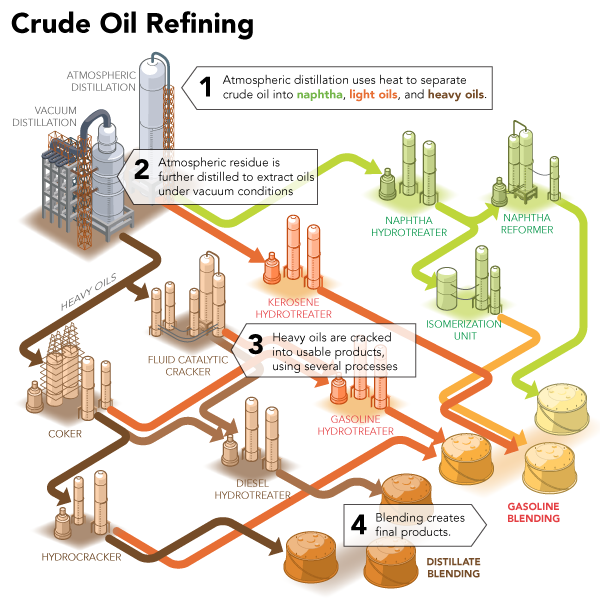From the outside, an oil refinery may look like an endless maze of pipes, chimney stacks, steel columns, and vessels. The fact is, however, oil refineries are highly sophisticated industrial facilities transforming crude oil into valuable products used in an array of applications.
Unprocessed oil is not very useful in its original form. An oil refinery or petroleum refinery is an industrial process plant where crude or “unprocessed” oil is processed and refined into more useful products such as petroleum naphtha, gasoline, diesel fuel, asphalt base, heating oil, kerosene, and liquefied petroleum gas.
The issue with crude oil is that it contains hundreds of different types of hydrocarbons all mixed together. They have to be separated into different fractions to produce anything of value. This is where an oil refinery comes into play.
Today, pipelines, trains, tankers, and trucks transport crude oil to refineries where it is transformed into the products we use every day. The crude oil can be processed in two ways. The most common way is a process called fractional distillation and the newer techniques use chemical processing.
- Fractional Distillation: is used for separating a mixture of substances with narrow differences in boiling points, and is the most critical step in the refining process.
- Chemical Processing: Breaks longer chains into shorter ones (cracking). Or by combining smaller pieces to make larger ones (unification).

Oil refineries are large, industrial complexes with extensive piping running throughout, carrying streams of liquids between large chemical processing units. Each step in the separation process requires careful monitoring and a great deal of insulation. Mechanical insulation is needed throughout the entire facility in order to aid with the processing of the crude oil.
The largest area of oil processing in the United States can be found on the Gulf Coast. It’s is also the area with the greatest need of industrial insulation solutions and products. Insulation materials such as calcium silicate and stone wool are the primary insulators. Each offers unique advantages and disadvantages. Learn more about the two commonly used materials by downloading our Cost Advantages of V-groove vs. Calcium Silicate Guide.
Work Cited:
Freudenrich, Ph.D. Craig. “How Oil Refining Works.” HowStuffWorks Science, HowStuffWorks, 4 Jan. 2001, science.howstuffworks.com/environmental/energy/oil-refining.htm.


